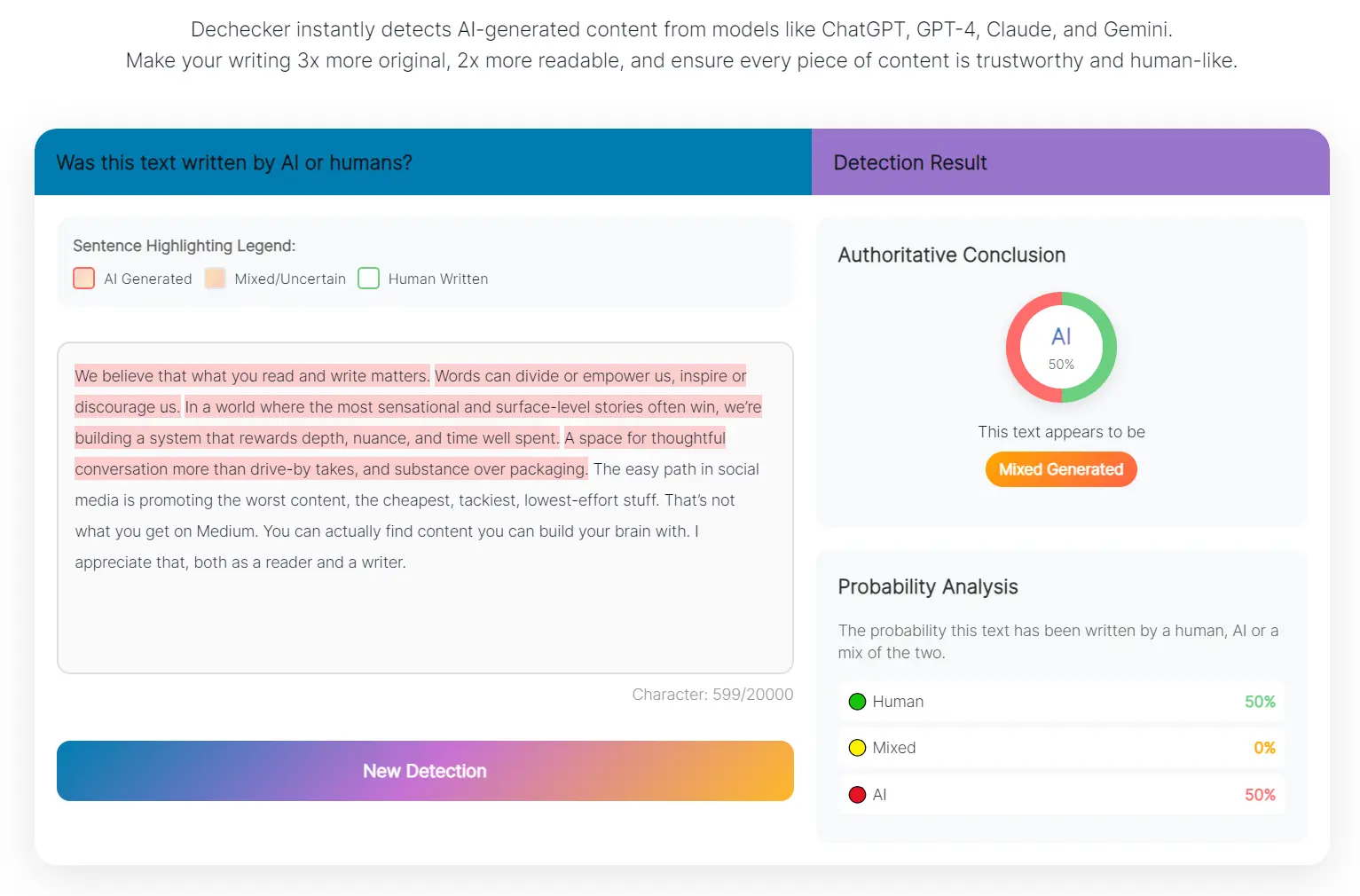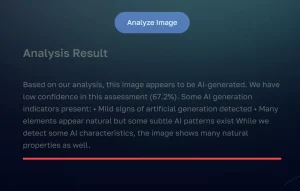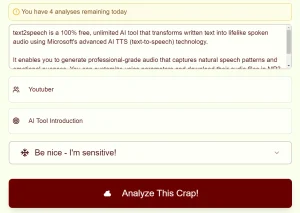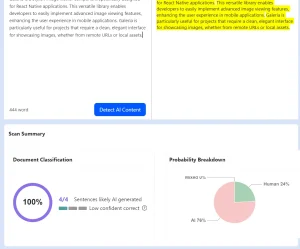Dechecker AI is a free AI content detection tool that identifies whether your content was generated by LLMs like ChatGPT, Claude, and Gemini.
The tool analyzes your text at the sentence level and provides probability scores showing whether the content is human-written, AI-generated, or a mix of both.
No signup required, no usage limits, and you can scan up to 20,000 characters per submission.
Features
- Sentence-Level AI Detection: Dechecker AI highlights specific sentences that appear to be AI-generated. This allows for targeted edits rather than just providing an overall AI probability score.
- Multi-Language Support: The tool can detect AI-generated content in various languages beyond English for global content verification.
- Detailed Reports: Each scan generates a report showing detection percentages broken down into three categories (human, mixed, AI) with an authoritative conclusion.
Use Cases
- Academic integrity verification: Educators and students can check essays and research papers for undisclosed AI assistance.
- Content quality assurance: Bloggers and marketers identify AI-generated sections that need humanization before publishing.
- Client work validation: Freelancers verify content originality before delivery to maintain credibility.
Case Studies
I ran several tests on Dechecker to understand its detection capabilities across different AI models and content types. These tests reveal both the tool’s strengths and its limitations.
Testing Different AI Models
I used the same prompt across three major AI platforms and scanned each output through Dechecker. The results varied significantly by model:
Gemini Pro 2.5 generated text that Dechecker flagged at 68% AI probability with high confidence. The tool correctly identified the content as AI-generated with a clear breakdown showing 32% human probability and 0% mixed content.
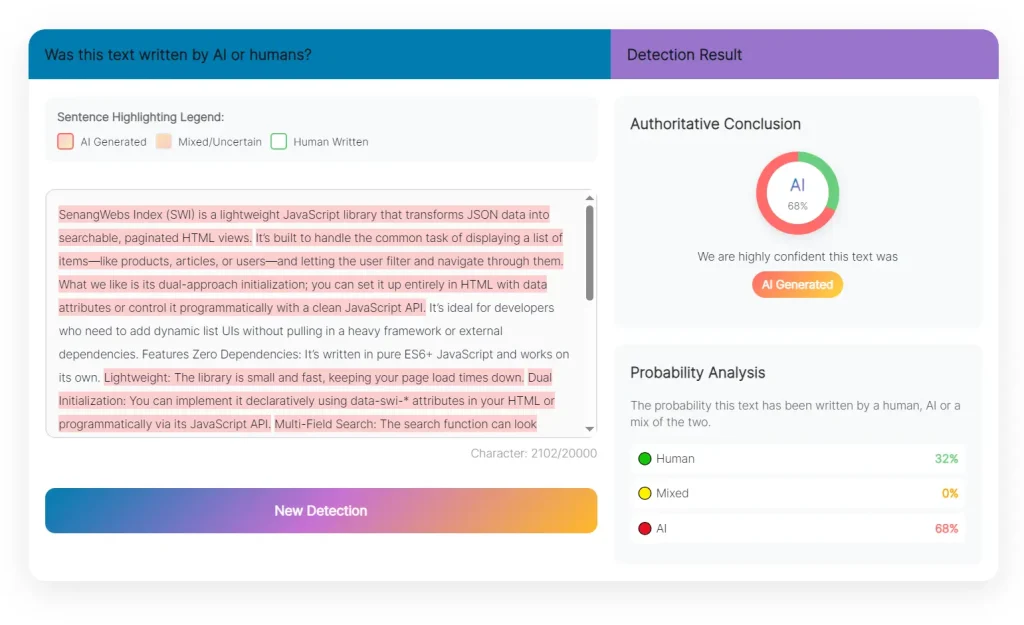
Claude 4.5 Sonnet produced content that scored even higher at 81% AI probability. Again, Dechecker showed high confidence in its AI-generated classification with 19% human probability and no mixed content detected.
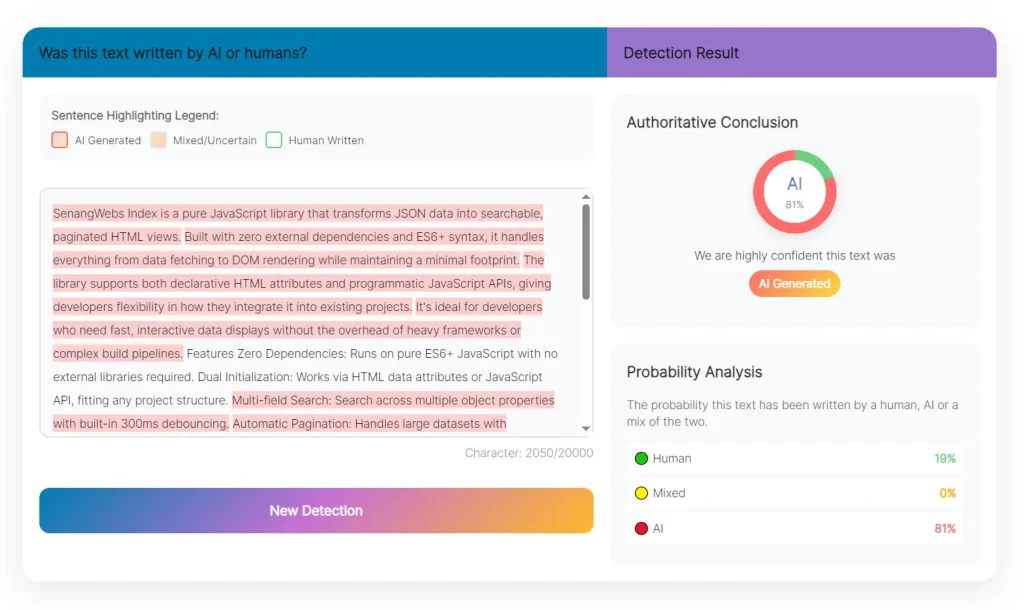
GPT-5 presented an interesting outlier. Content from this model scored only 2% AI probability, with Dechecker classifying it as human-generated at 98% confidence. This suggests the tool’s training data may not fully account for GPT-5’s writing patterns yet, or that GPT-5 produces more human-like output that evades detection.
Testing Humanized and Real Human Content
Next, I tested it with an article that was first generated by AI and then “humanized” to evade detection, alongside a genuine article from a BBC journalist.
AI Humanized Article: The tool was largely fooled, identifying the text as human-generated with only an 11% AI score. This shows that while it can detect raw AI output, it can be bypassed with some editing.
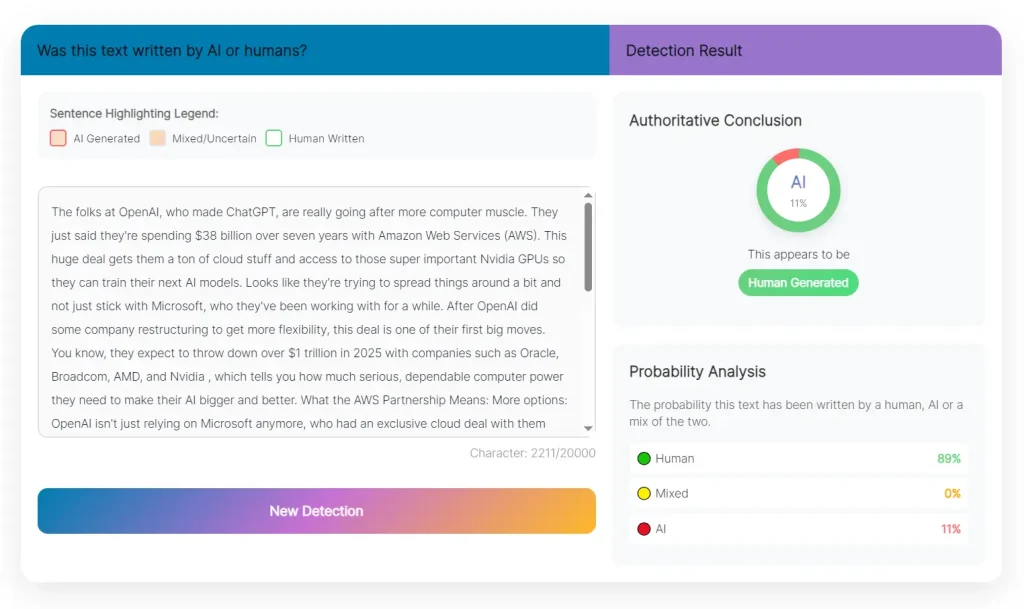
BBC Article: It correctly identified the journalist’s work as human-generated, with a low 9% AI score. This is a good sign that it doesn’t produce many false positives on genuinely human-written content.
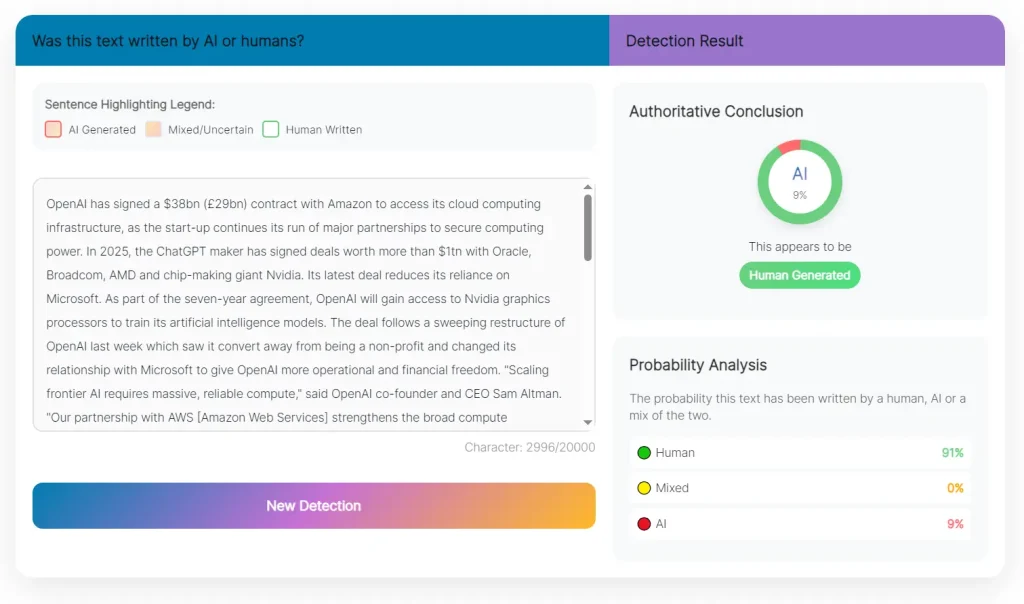
These tests indicate that Dechecker AI is quite effective at identifying content from established AI models like Gemini and Claude. However, its accuracy appears to diminish with more advanced models like GPT-5 or with content that has been intentionally edited to appear more human.
How To Use It
1. Copy the content you want to analyze and paste it into the AI Checker Tool on the Dechecker website. It currently accepts up to 20,000 characters at once.
2. Click the “Detect Text” to start the analysis. The scan runs in a few seconds and processes your text through Dechecker’s detection algorithms.
3. Review your results, which appear in two main sections. The authoritative conclusion shows an overall AI percentage and a confidence statement (like “We are highly confident this text was AI Generated”). Below that, the probability analysis breaks down the likelihood into three categories using a visual scale with green for human, yellow for mixed, and red for AI percentages.
4. The tool highlights specific sentences that triggered AI detection. This color-coded text lets you identify exactly which parts need attention.
Pros
- Zero Barriers to Entry: The complete absence of signup requirements, usage limits, or payment walls means you can start checking content immediately.
- Granular Sentence-Level Feedback: Rather than just telling you a document is 70% AI-generated, the tool shows you exactly which sentences triggered detection.
- Generous Character Limit: 20,000 characters per scan handles most documents in a single pass, unlike tools that max out at 1,000-1,500 words.
- Fast Processing Speed: Results appear in seconds rather than minutes.
Cons
- Variable Accuracy Across Models: As my testing showed, detection accuracy differs significantly by AI model. GPT-5 content scored only 2% AI probability, suggesting the tool may not recognize newer model outputs effectively.
- Vulnerability to Humanization Tools: AI-humanized content scored only 11% AI probability, showing that content processed through humanization tools can evade detection.
Related Resources
- 7 Best Free AI Content Detectors: I tested 7 free AI content detectors using an AI-humanized article and BBC journalism. See complete test data, rankings, and which detector to use for your specific needs in 2025.
FAQs
Q: What should I do if my human-written content gets flagged as AI-generated?
A: False positives happen with all AI detectors. If your original writing gets flagged, focus on varying your sentence structure, adding more specific examples and personal insights, and incorporating a more conversational tone. The sentence-level highlighting shows you exactly which parts triggered detection, so you can revise those specific sections rather than rewriting everything.
Q: Can I use Dechecker’s detection results as proof that content is or isn’t AI-generated?
A: AI detection tools provide probability estimates, not definitive proof. Dechecker’s results should inform your assessment, but shouldn’t be the sole determining factor for important decisions about content authenticity. Academic institutions and employers increasingly recognize that detection tools have limitations and can produce both false positives and false negatives.
Q: How accurate is Dechecker AI compared to paid detection tools?
A: For major AI models like ChatGPT and Claude, it performs comparably to entry-level paid tools.
